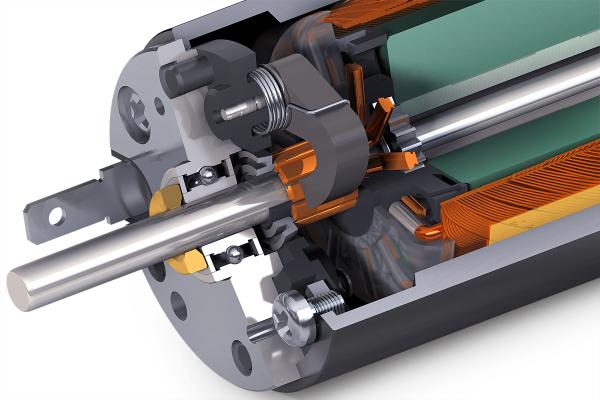Spur gearhead are designed in such a way that two gears (single stage) work together to increase the torque potential of the driving motor. Each gear in the train of a spur gearhead bears the entire torque load, and therefore these gearheads are used where lower torques are specified. Backlash is also a common concern when using a gearhead. Backlash depends on the shape and accuracy of the gear teeth and the accuracy of the gear wheel mounting arrangement. The same goes for efficiency. The interplay between these two—backlash and efficiency—is that an increase in mechanical play between gears is good for efficiency and bad for backlash. In general, spur gearheads are the simpler and least expensive of the two units.
Planetary gearheads are more complex in design
The input shaft drives the central (sun) gear, which then turns the surrounding (planet) gears, which allows each of the planet gears to deliver torque in perfect synchronization with the others. For planetary gearheads the torque load is shared over multiple ‘planet’ gears, which leads to greater torque output capacity, and takes the pressure off of each individual gear.
Both types of gearhead are made from a variety of metals and plastics, including brass, steel, nickel-steel, and other alloys. Important design factors include the size of the gears and the number of teeth on each of those gears. This determines the gear ratios for output torque and the shaft speed.
With proper machining you attain the same backlash from both spur and planetary gearheads. For standard gears this ranges from 1 to 2 degrees. Planetary and spur gearheads can provide up to 90 percent efficiency for a single stage unit. (All gearheads can include multiple stages, but that approach also adds to the length of the device.) Reduction ratios for both spur and planetary gearheads range from near unity up to several thousand to one.
Generally, spur gearheads are quieter than planetary gearheads. On all gearheads, noise increases at higher speeds, but note that noise is a function of tooth shape, the interaction of the teeth, and the material used. Steel cut gears are the most durable, making them ideal for high-torque applications, while porous sintered gearwheels are better at holding lubricants. (Lubrication is a factor when service life is a consideration.)
Most often, the selection of which gearhead type to use relates to the torque capability of the gearhead, while the selection of the reduction ratio primarily relates to the input speed limit required for the application. Whether spur or planetary, speed mainly depends on what the device is designed for. Tooth shape design is an optimization and compromising process, which affects speed, torque, efficiency, and backlash, as well as noise level—and all combinations of these factors.


